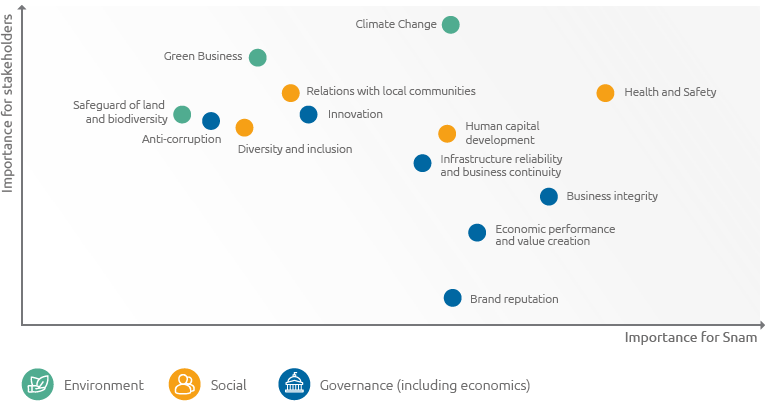Material issues in relation to the activities carried out
Materiality analysis
In order to identify the environmental, social and personnel-related issues, with respect to human rights and the fight against active and passive corruption considered material, taking into account the activities and characteristics of the business, the Company, in the same way as every year, has updated its materiality analysis aimed at identifying the most significant issues for the Group and for stakeholders under the scope set out in Legislative Decree 254/2016 and subsequent supplements, to the extent necessary to ensure the understanding of the Snam Group operations, its performance, results and impact it produces.
Materiality is the principle of reference to better focus the reporting of activities on materiality issues or sustainability issues that best reflect the organisation’s economic, environmental and social impacts or that influence stakeholders’ decisions.
At the end of 2019 Snam launched an activity for the updating of the universe of issues that historically are part of its sustainability framework. Specifically, the analysis process started with identifying the issues reported in the main sustainability trends, the most important industry publications and through a benchmark with the main peer companies comparable with Snam at a national and international level. The directions provided by the Sustainability Accounting Standards Board (SASB), for the Extractives & Minerals Processing: Oil & Gas midstream” sector were also taken into consideration.
To define the most relevant issues from the company’s point of view, the internal documentation available was analysed (e.g. 2019-2023 Strategic Plan), the main policies adopted, the main risks identified by the ERM model and the sustainability issues emphasised. The preliminary internal relevance of the issues identified in this way was then submitted to management, through interviews directed at the heads of each function, in order to analyse the perception of the issues from the company’s perspective. Specifically, each function, where deemed appropriate, was able to update the arrangements for these issues.
On the other hand, in order to define the most significant issues from the perspective of stakeholders, the analyses described above were used, identifying the most recurrent and more significant themes. The arrangements produced were then integrated with the results of the online survey sent to all categories of stakeholders and the specific workshops dedicated to employees, customers and suppliers. The following categories of stakeholders were involved in the various analyses: Communities and local areas, Investors and lenders, Other operators, Media, Suppliers, Customers, People (Employees) and Authorities and Institutions.
THE INVOLVEMENT OF STAKEHOLDERS
In order to integrate the external perspective of stakeholders in its materiality analysis, Snam has directly involved several categories of stakeholders by holding dedicated workshops. These workshops, held at three different times, involved the representatives of the categories customers, suppliers and employees, who were asked to give their opinions on the relevance of specific themes. After an introduction on Snam’s position on the issue of sustainability, this was followed by a brief induction on the concept of “materiality” and the analyses conducted to identify the relevant issues. Later on, stakeholders were asked to evaluate the significance of the themes of sustainability through the following activities:
- validation of the universe of issues;
- prioritisation of the issues validated in this way through the use of a hard copy questionnaire and an online tool.
The results of the workshop, together with the preliminary analyses described above (trend, sector and benchmark), have made it possible to determine the external relevance of sustainability issues.
This activity, met with a very positive final judgement by the participants, who appreciated the involvement method and issues dealt with.
2019 materiality matrix

The joint consideration of internal and external significance led to identifying areas of priority and materiality. The materiality matrix was validated by management, the ESG Committee and the CEO.
The analyses described above also made it possible to identify further issues which, although not material, are, however, relevant for Snam or its stakeholders. These are: Waste management, Management of water resources, Employment, Relations with the authorities and quality of services, Relations with local communities, Respecting human rights, Protection of the air.
These themes were analysed and prioritised, but in relation to Snam’s activities and the evaluations of stakeholders, as they do not come under the category of material issues. These aspects are, however, closely supervised and monitored by the Company.
Results of the materiality analysis with respect to the Decree
The material issues within the areas covered by Legislative Decree 254/2016 and subsequent supplements are those relating to Health and Safety, Climate change, Protecting local areas and biodiversity, Green business, Economic performance and creation of value, Reliability of infrastructure and business continuity, Brand reputation, Innovation, Relations with local communities, Development and protection of human capital, Fight against corruption, Business integrity, Diversity and inclusion.
Scope of the decree |
2019 material issues |
Reference GRI standards |
|---|---|---|
Environment and health and safety |
Climate change, Green business, Health and safety, Protecting the environment and biodiversity |
GRI 302 Energy 2016 |
Social aspects |
Reliability of infrastructure and business continuity, Innovation, Economic performance and creation of value, Relations with local communities, Brand reputation |
GRI 201 Economic Performance 2016 |
Aspects concerning the management of personnel |
Diversity and inclusion, Development and protection of human capital |
GRI 401 Employment 2016 |
Protecting Human Rights |
Diversity and inclusion |
GRI 406 Non discrimination 2016 |
Prevention of active and passive corruption |
Business Integrity, Fight against corruption |
GRI 205 Anti-corruption 2016 |